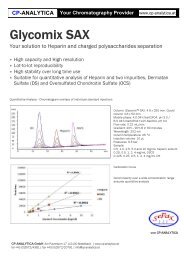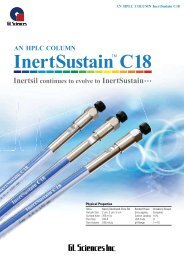Small Particle HPLC Columns - Cp-Analytica
Small Particle HPLC Columns - Cp-Analytica
Small Particle HPLC Columns - Cp-Analytica
You also want an ePaper? Increase the reach of your titles
YUMPU automatically turns print PDFs into web optimized ePapers that Google loves.
2<br />
<strong>HPLC</strong> COLUMNS<br />
Column Selection<br />
Becky Wittrig<br />
<strong>HPLC</strong> Products<br />
Marketing Manager<br />
6+ years of service!<br />
ordering note<br />
For assistance in selecting<br />
an <strong>HPLC</strong> column, please<br />
contact Restek Technical<br />
Service at 814-353-1300 or<br />
800-356-1688 (ext. 4) or<br />
support@restek.com.<br />
Free Literature<br />
<strong>HPLC</strong> Tech Tips Wall Chart<br />
Almost everything you need to<br />
remember about <strong>HPLC</strong>, condensed<br />
into 3 feet by 2 feet:<br />
mobile phase basics, buffers<br />
(types, pK a values, pH ranges,<br />
formula masses, more), miscibility<br />
and solubility chart<br />
(invaluable!), system setup and<br />
optimization, detector tips,<br />
pressure conversion factors,<br />
most-used chromatographic<br />
equations, column storage<br />
essentials.<br />
(lit. cat.# 59894A)<br />
Selecting an <strong>HPLC</strong> Column<br />
Choosing the best column for your application requires consideration of stationary phase chemistry,<br />
retention capacity, particle size, and column dimensions. Identifying the best stationary phase for your<br />
separation is the most critical step of column selection, and your decision should be based on sample<br />
solubility and the chemical differences among the compounds of interest. Figure 1 is a handy tool for<br />
stationary phase selection.<br />
Figure 1 Stationary phase selection.<br />
Water or<br />
Polar Organics<br />
Phone: 800-356-1688 or 814-353-1300<br />
www.restek.com<br />
Sample Solubility<br />
Reversed Phase Normal Phase<br />
Acidic<br />
Ionic<br />
Aqueous<br />
C18<br />
IBD<br />
Organic<br />
Acids<br />
Basic<br />
Amino<br />
Cyano<br />
Basix<br />
IBD<br />
PFP<br />
PFP Propyl<br />
C1<br />
C4<br />
C8<br />
Neutral<br />
Hydrophobic<br />
C18<br />
Phenyl<br />
Biphenyl<br />
Hydrophilic<br />
Aqueous<br />
C18<br />
IBD<br />
Organic<br />
Acids<br />
Mixed<br />
Basix<br />
IBD<br />
Nonpolar<br />
Organics<br />
Silica<br />
Cyano<br />
Amino<br />
IBD<br />
Reversed phase columns (e.g. alkyl, phenyl, cyano) work well for water-soluble hydrophobic compounds.<br />
Some stationary phases incorporate both polar and nonpolar functionality and can be used in either<br />
reversed phase or normal phase modes (e.g. Ultra IBD, Allure® Basix, and Allure® PFP Propyl). While<br />
straight chain alkyl (e.g. C18) stationary phases are historically the most commonly used, many newer<br />
phases provide better separations. Alkyl phases are best suited for analyzing neutral compounds with a<br />
high ratio of carbon:heteroatoms where the major distinction among analytes is their hydrophobicity.<br />
However, for analyzing compounds that are highly polar, aromatic, or halogenated, nonalkyl stationary<br />
phases often provide significantly better selectivity (Figure 2).<br />
Retention capacity is another important consideration and is influenced by surface area and carbon load<br />
(% carbon in the packing material). Allure® columns were designed for maximum retention using a high<br />
density of ligands bonded to a large surface area silica. Ultra, Kromasil®, Pinnacle II and Pinnacle DB<br />
columns have the same high ligand density, but are more moderately retentive due to their lower surface<br />
areas. Surface area is inversely proportional to pore size; thus, larger pore sizes result in less retention.<br />
However, wide pore (e.g. 300Å) packings, such as Viva, are ideal when analyzing larger molecules, as a<br />
larger pore size is necessary to allow the analytes to ‘fit’ into the pores.<br />
<strong>Particle</strong> size and column dimensions also influence column choice. In selecting a particle size, the primary<br />
consideration is efficiency (plates/meter) versus column pressure. A 3µm column will have approximately<br />
50% more efficiency than a 5µm column, if all other conditions are constant for both columns. As<br />
particle size is further decreased (e.g.






